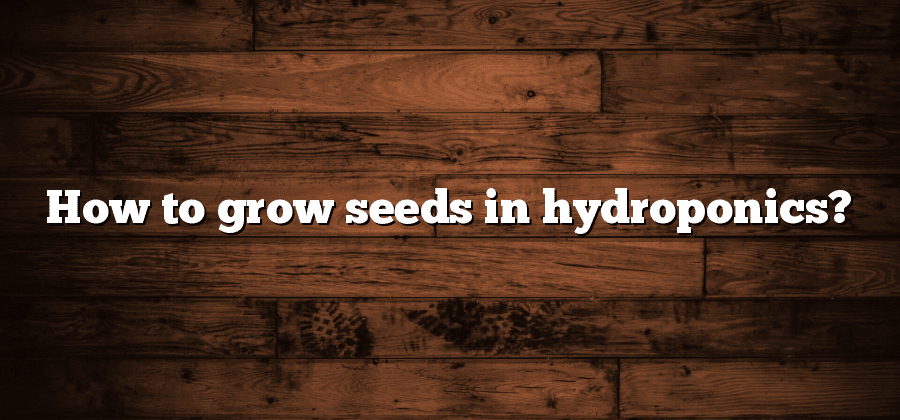Choosing the Right Seeds
One of the most critical factors in hydroponic gardening is selecting the right seeds to ensure a successful and bountiful harvest. When choosing seeds for your hydroponic system, it is essential to consider the plant’s growth characteristics, environmental requirements, and desired yield.
First and foremost, it is essential to select seeds that are suitable for hydroponic cultivation. Look for varieties that have been specifically bred or adapted for soil-less growing systems. These seeds are typically referred to as “hydroponic” or “indoor” varieties and are specifically designed to thrive in nutrient-rich water solutions. By choosing these types of seeds, you ensure that your plants are genetically predisposed to excel in a hydroponic environment. Additionally, these seeds often exhibit higher disease resistance and faster growth rates, allowing for quicker and more efficient cultivation.
Selecting the Ideal Growing Medium
When it comes to hydroponic gardening, selecting the ideal growing medium is crucial for the success of your plants. Unlike traditional soil gardening, hydroponic systems rely on a different medium to provide support and nutrients to the plants. The growing medium serves as a substitute for soil, allowing the plants to anchor their roots and absorb necessary nutrients in a water-based environment.
One popular choice for hydroponic systems is coconut coir. Made from the fibrous husk of coconut shells, coconut coir is an environmentally friendly and sustainable option. It has excellent water retention properties while still providing adequate drainage, making it ideal for hydroponic gardening. Additionally, coconut coir is pH-neutral, which helps to maintain a balanced and optimal growing environment for your plants.
Another commonly used growing medium in hydroponics is perlite. This lightweight volcanic rock has excellent drainage properties and allows for ample oxygenation of the plant roots. Perlite is sterile and pH-neutral, which makes it a great choice for preventing the growth of harmful bacteria and maintaining a healthy root zone. Its porous nature also ensures that water is evenly distributed throughout the system, promoting healthy and vigorous plant growth.
Providing Optimal Lighting Conditions
When it comes to hydroponic gardening, providing optimal lighting conditions is crucial for the success of your plants. In a hydroponic system, natural sunlight is often insufficient, particularly during the winter months or in indoor setups. Therefore, it is essential to invest in quality lighting fixtures that can effectively simulate the spectrum and intensity of natural sunlight for your plants.
LED (Light Emitting Diode) lights are widely recommended for hydroponic gardening due to their energy efficiency and customizable light spectrum. These lights can be tailored to specific plant requirements, such as promoting vegetative growth or encouraging flowering and fruiting. Additionally, LED lights produce less heat than traditional HID (High Intensity Discharge) lights, reducing the risk of overheating and damage to your plants. Remember to position your lights at the correct distance from your plants, ensuring they receive an even amount of light and minimizing the risk of light burn.
To further optimize lighting conditions, consider implementing a lighting schedule that closely mimics natural daylight cycles. Most plants require an adequate amount of darkness to carry out essential processes such as respiration and hormone regulation. By providing a consistent lighting schedule with designated periods of darkness, you can help your plants establish a healthy growth rhythm and maximize their overall productivity.
Maintaining Proper Nutrient Levels
The success of any hydroponic system relies heavily on maintaining proper nutrient levels. It is crucial to provide your plants with the essential nutrients they need to thrive and produce high-quality yields. Nutrients are necessary for plant growth and can be divided into macronutrients and micronutrients. Macronutrients, such as nitrogen, phosphorus, and potassium, are required in large quantities, while micronutrients, like iron and zinc, are needed in smaller quantities.
One way to ensure adequate nutrient levels is by monitoring the nutrient solution regularly. This involves checking the electrical conductivity (EC) and pH levels to ensure they are within the optimal range for plant growth. The EC measures the concentration of nutrients in the solution, while pH determines its acidity or alkalinity. By regularly monitoring and adjusting these levels, you can prevent nutrient deficiencies or toxicities, which can negatively impact plant health and productivity. Additionally, it is essential to follow the manufacturer’s instructions when adding nutrient solutions to prevent over-fertilization or imbalances that could harm your plants.
Regulating pH Levels in the Hydroponic System
Hydroponic systems provide an efficient and controlled environment for growing plants, but one crucial factor that can greatly impact plant health is the pH level of the nutrient solution. pH levels measure the acidity or alkalinity of a solution and can affect nutrient availability and uptake. It is essential to regulate pH levels in the hydroponic system to ensure optimal nutrient absorption and overall plant growth.
Maintaining a pH level within the recommended range is vital for the hydroponic system’s success. Generally, most plants prefer a slightly acidic environment with a pH range of 5.5 to 6.5. However, specific plants may have different preferences, so it is crucial to research and tailor the pH levels accordingly. Regular monitoring of the pH levels using a pH meter or test kit is necessary to identify any fluctuations and take appropriate measures to correct them.






